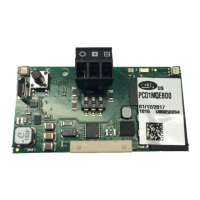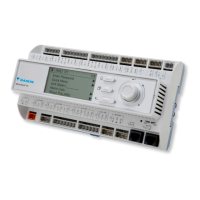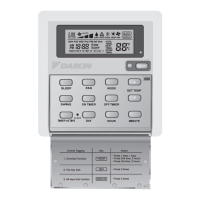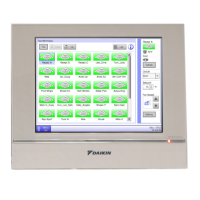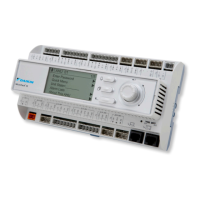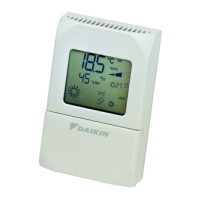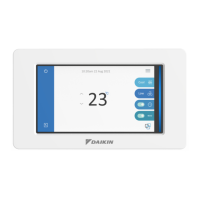ED 15103-6 • MICROTECH III WSHP UNIT CONTROLLER 36 www.DaikinApplied.com
ComprehensIve daTa Tables
Table 18: Network Variable Inputs (NVIs) - SmartSource Single and Two Stage Compressor and Ennity Large Two
Compressor, Continued
Point Name
lonWorks Variable
(NV Index
2
)
SNVT Type
(SNVT Index)
Range/
Default
(in Units)
Heart-
beat
Description
Network Variable Inputs (NVIs)
Energy Hold Off Input
nviEnergyHoldOff
(12)
SNVT_switch
(95)
Default: Null Recv
When the unit is in the Energy Hold Off mode, it uses
Standby setpoints. This command has priority over Effective
Occupancy.
3
The network override will revert back to its
default value upon unit controller reboot.
Selection State Value
Normal 0 NA
Normal 1 0%
HoldOff 1 0.5 to 100%
Null -1 0%
Fan ON/Auto
Remote Input
nviFanOnAuto
(15)
SNVT_switch
(95)
Default: Null No
Overrides the local fan ON/Auto room sensor and thermostat
switch inputs. The Fan Auto setting forces cycling fan mode.
Fan On forces the fan ON. The network override will revert
back to its default value upon unit controller reboot.
Selection State Value
Fan On 0 0%
Fan Auto 1 100%
Null -1 0 to 100%
Fan Runtime Totalizer
nviFanHours
(21)
SNVT_count
(8)
0 to 65535 counts
Default: 0
No Total fan runtime hours.
4
Humidistat Remote
Input
nviHumidistat
(16)
SNVT_switch
(95)
Default: Null No
Overrides the local humidistat/Stage #1 Cooling thermostat
input. The network override will revert back to its default value
upon unit controller reboot.
Selection State Value
No Dehumid Req 0 0%
Req Dehumid 1 100%
Null -1 0 to 100%
Occupancy
Override Input
nviOccManCmd
(13)
SNVT_occupancy
(109)
Default: OC_NUL No
Overrides the occupancy schedule. Occupancy Schedule
Override has priority over the Occupancy Schedule and
remote occupancy sensor. It is also allows a local timed
override hardwired to place the unit in the Occupied mode
during the amount of time declared in Timed Override
Setpoint using Schedule Override and/or an occupancy
sensor. The network override will revert back to its default
value upon unit controller reboot. See Effective Occupancy
Modes.
Supported Values
0 = OC_OCCUPIED
1 = OC_UNOCCUPIED
2 = OC_BYPASS
3 = OC_STANDBY
-1 (0xFF) = OC_NUL
Occupancy Scheduler
Input
nviOccSchedule
(17)
SNVT_tod_event
(128)
Default: OC_NUL Recv
Commands the WSHP into different occupancy modes. A
scheduler or a supervisory controller typically sends the
command using Schedule Override.
3
The network override
will revert back to its default value upon unit controller reboot.
See Effective Occupancy Modes.
Supported Current_state Values
0 = OC_OCCUPIED
1 = OC_UNOCCUPIED
3 = OC_STANDBY
-1 (0xFF) = OC_NUL
• Next_state is not used
• Time_to_next_state is not used
Occupancy
Sensor Input
nviOccSensor
(18)
SNVT_occupancy
(109)
Default: OC_NUL Recv
Indicates the presence of occupants in the space (motion
detection.)
3
The network override will revert back to its default
value upon unit controller reboot. See Effective Occupancy
Modes.
Supported Values
0 = OC_OCCUPIED
1 = OC_UNOCCUPIED
-1 (0xFF) = OC_NUL
1. Analog Null (0x7FFF) is a discrete temperature value of 621.806ºF/327.67ºC. Its purpose is to indicate a sensor failure condition or when the unit controller is not
using that temperature value.
2. The Network Variable index number is a unique identier for certain LonWorks variables. Some BAS companies use this numeric value instead of text to
reference these variables. The NV index number can also be found in the XIF le.
3. After Receive Heartbeat is enabled, this variable reverts to the default (non-override) value if it is not refreshed often enough through a network command or if
communication is disabled (i.e. the device is disabled or is ofine).
4. The totalizer continues to increment until the maximum count is reached, at which point the BAS must reset the value by issuing a write command. The variable is
saved in nonvolatile memory every 24 hours. If power is lost, that day’s totalizer information is not stored.
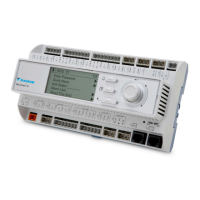
